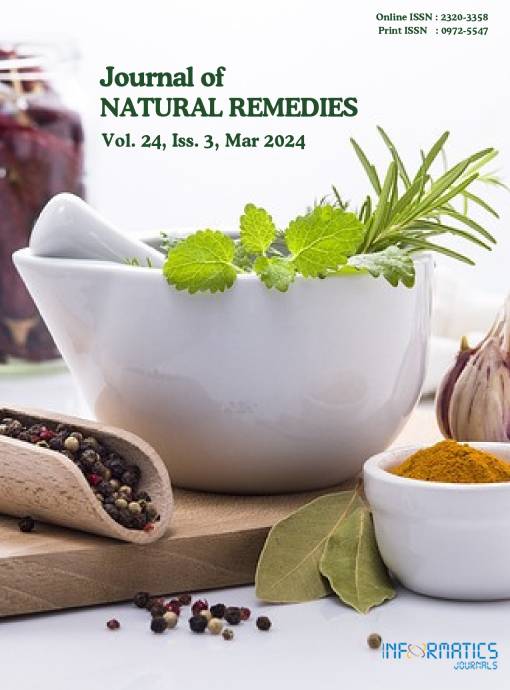Phytochemical Screening of Diospyros paniculata Bark and In Vitro Cytotoxic Study on Human Breast Cancer Cell Line
DOI:
https://doi.org/10.18311/jnr/2024/34642Keywords:
Betulin, Cytotoxicity, Diospyros paniculata, Lupeol, MCF-7Abstract
Medicinal plants are the resource of traditional medicines and modern medicine is also developed indirectly from plants. In traditional medicinal practices such as Ayurveda and Unani, Diospyros paniculata has been recognised for its medicinal properties. Different parts of the plant, including the leaves, bark, fruits, and seeds, are utilised to prepare various herbal remedies and these species show a richness of triterpenoids, naphthoquinones and naphthaldehydes which majorly contribute to the anticancer activity. D. paniculata bark was extracted with methanol and fractionated by low-polar to high-polar solvents. In-vitro cytotoxic activity of each solvent fraction was studied on the MCF-7 (Human Adenocarcinoma) cell line by MTT assay. The ethyl acetate fraction shows a significant IC50 value of 23.47 µg/ml which might be due to the presence of principal compounds in the fraction. Methanol fraction showed a moderate IC50 value. To isolate chemicals, the chloroform fraction underwent column chromatography. Fourier Transform Infrared Spectroscopy (FTIR), 1H NMR (Nuclear Magnetic Resonance Spectroscopy), and 13C NMR were used to characterise the isolated chemicals. Two compounds were isolated from chloroform fraction identified as Betulin and Lupeol.
Downloads
Metrics
Downloads
Published
How to Cite
Issue
Section
License
Copyright (c) 2024 Pooja Kagawad, Parixit Bhandurge, Rohan Singadi, Shailendra Suryawanshi, Kiran Gaikwad (Author)

This work is licensed under a Creative Commons Attribution 4.0 International License.
Accepted 2024-01-05
Published 2024-03-01
References
Liu EH, Qi LW, Wu Q, Peng YB, Li P. Anticancer agents derived from natural products. Mini Reviews in Medicinal Chemistry. 2009; 9(13):1547-55. https://doi.org/10.2174/138955709790361520 PMid:20205636.
Ferlay J, Colombet M, Soerjomataram I, Parkin DM, Piñeros M, Znaor A, Bray F. Cancer statistics for the year 2020: An overview. International Journal of Cancer. 2021; 149(4):778-89. https://doi.org/10.1002/ijc.33588 PMid:33818764.
Dushimemaria F, Du Preez CI, Mumbengegwi DR. Randomized anticancer and cytotoxicity activities of Guibourtia coleosperma and Diospyros chamaethamnus. African Journal of Traditional, Complementary and Alternative Medicines. 2017; 14(4):1-7. https://doi.org/10.21010/ajtcam.v14i4.1 PMid:28638861 PMCid: PMC5471456.
Thomford NE, Senthebane DA, Rowe A, Munro D, Seele P, Maroyi A, Dzobo K. Natural products for drug discovery in the 21st century: Innovations for novel drug discovery. International Journal of Molecular Sciences. 2018; 19(6):1578. https://doi.org/10.3390/ijms19061578 PMid:29799486 PMCid: PMC6032166.
Shankara BR, Ramachandra YL, Rajan SS, Ganapathy PS, Yarla NS, Richard SA, Dhananjaya BL. Evaluating the anticancer potential of ethanolic gall extract of Terminalia chebula (Gaertn.) Retz. (combretaceae). Pharmacognosy Research. 2016; 8(3):209. https://doi.org/10.4103/0974-8490.182919 PMid:27365992 PMCid: PMC4908852.
Samuel R, Turner B, Duangjai S, Munzinger J, Paun O, Barfuss MH, Chase MW. Systematics and evolution of the Old World Ebenaceae, a review with emphasis on the large genus Diospyros and its radiation in New Caledonia. Botanical Journal of the Linnean Society. 2019; 189(2):99-114. https://doi.org/10.1093/botlinnean/boy081
Duangjai S, Wallnöfer B, Samuel R, Munzinger J, Chase MW. Generic delimitation and relationships in Ebenaceae sensu lato: Evidence from six plastid DNA regions. American Journal of Botany. 2006; 93(12):1808-27. https://doi.org/10.3732/ajb.93.12.1808. PMid:21642127
Maridass M, Ghanthikumar S, Raju G. Preliminary phytochemical analysis of Diospyros species. Ethnobotanical Leaflets. 2008; (1):118.
Mohamed SA, Gandhidasan R, Charles JA. Two 2-naphthoic acids from Diospyros paniculata. Indian J Chem 2006; 45(B):1544-46. https://doi.org/10.1002/chin.200640213
G Ravelo A, Estévez-Braun A, Chávez-Orellana H, Pérez-Sacau E, Mesa-Siverio D. Recent studies on natural products as anticancer agents. Current Topics in Medicinal Chemistry. 2004; 4(2):241- 65.https://doi.org/10.2174/1568026043451500 PMid:14754457.
Sinha BN, Bansal SK, Pattnaik AK. Phytochemical and antimicrobial activity of extracts, fractions and betulin, 7-methyl juglone obtained from Diospyros paniculata. Journal of Natural Remedies. 2009; 9(1):99-102. https://doi.org/10.183/jnr/2009/228
Abubakar AR, Haque M. Preparation of medicinal plants: Basic extraction and fractionation procedures for experimental purposes. Journal of Pharmacy and Bioallied Sciences. 2020; 12(1):1-10. https://doi.org/10.4103/jpbs.JPBS_175_19 PMid:32801594 PMCid: PMC7398001.
Revathy S, Elumalai S, Antony MB. Isolation, purification and identification of curcuminoids from turmeric (Curcuma longa L.) by column chromatography. Journal of Experimental Sciences. 2011; 2(7):21-25.
Damiani E, Solorio JA, Doyle AP, Wallace HM. How reliable are in vitro IC50 values? Values vary with cytotoxicity assays in human glioblastoma cells. Toxicology Letters. 2019; 302:28-34. https://doi.org/10.1016/j.toxlet.2018.12.004 PMid:30562549.
Król SK, Kiełbus M, Rivero-Müller A, Stepulak A. Comprehensive review on betulin as a potent anticancer agent. BioMed Research International. 2015; 2015:584189. https://doi.org/10.1155/2015/584189 PMid: 25866796 PMCid: PMC4383233.
Hordyjewska A, Ostapiuk A, Horecka A, Kurzepa J. Betulin and betulinic acid: Triterpenoids derivatives with a powerful biological potential. Phytochemistry Reviews. 2019; 18:929-51. https://doi.org/10.1007/s11101-019-09623-1
Chaturvedi PK, Bhui K, Shukla Y. Lupeol: Connotations for chemoprevention. Cancer Letters. 2008; 263(1):1-3. https://doi.org/10.1016/j.canlet.2008.01.047 PMid:18359153.

 Pooja Kagawad
Pooja Kagawad









 0.35
0.35 24
24 0.161
0.161